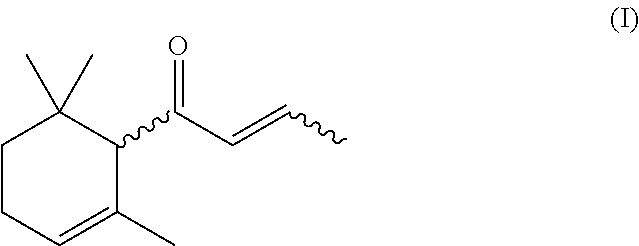Process for preparing alpha-damascone
a technology of alpha-damascone and alpha-damascone, which is applied in the preparation of organic compounds, chemical apparatus and processes, and organic chemistry, etc., can solve the problems of low yiels in the oxidation of these allylic alcohol intermediates, unsuitable processes for effective, and low overall yield. achieve the effect of high overall yield
- Summary
- Abstract
- Description
- Claims
- Application Information
AI Technical Summary
Benefits of technology
Problems solved by technology
Method used
Image
Examples
example 1
of 6,10-dimethylundeca-1,5,9-trien-4-ol from citral (step a)
[0141]To a stirred solution of citral (100 g, 0.65 mol) in dry THF (750 ml) was added allyl magnesium chloride (362.6 ml, 2M in THF, 0.72 mol) dropwise while maintaining the temperature between 0° C. to 5° C. After complete addition of allylmagnesium chloride reaction mixture was stirred for one hour at 0° C. and the progress of the reaction was monitored by TLC. After completion of reaction the mixture was quenched by adding saturated ammonium chloride solution (500 ml) at 0-10° C. The aqueous layer was extracted by ethyl acetate (3×50 ml) and the combined organic layer was concentrated to afford 127 g of compound 2 (99.5%).
[0142]1HNMR (300 MHz, CDCl3) δ 1.53 (s, 3H), 1.61 (s, 6H), 1.94-2.07 (m, 4H), 2.18-2.23 (m, 2H), 4.34-4.36 (m, 1H), 5.01-5.14 (m, 4H), 7.72-5.75 (m, 1H).
example 2
of 6,10-dimethylundeca-1,5,9-trien-4-one using TEMPO / Iron(III) nitrate nonahydrate / NaCl (step b)
[0143]Iron(III) nitrate nonahydrate (2.0 g, 5.1 mmol, 0.1 eq), TEMPO (0.79 g, 5.1 mmol, 0.1 eq) and solid NaCl (0.29 g, 51 mmol, 0.1 eq) was added to 50 ml of toluene at 25° C. To this mixture, the 6,10-dimethylundeca-1,5,9-trien-4-one obtained in example 1 (10.0 g, 51 mmol, 1 eq) was added at 25° C. and was stirred for 3 hours under oxygen atmosphere (O2 gas was continuously passed through the reaction mixture). The reaction was monitored by TLC and HPLC, which showed 50% conversion. After 3 hours of stirring an additional amount if Iron(III) nitrate nonahydrate (2.0 g, 5.1 mmol, 0.1 eq), TEMPO (0.79 g, 5.1 mmol, 0.1 eq), NaCl (0.29 g, 5.1 mmol, 0.1 eq) was added again to reaction mixture at 25° C. and the reaction mixture was then stirred for additional 2 hours. After consumption of almost 95% starting material (based on TLC and HPLC), the reaction mixture was diluted by adding toluene ...
example 3
of 6,10-dimethylundeca-1,5,9-trien-4-one using 4-OH TEMPO / Iron(III) nitrate nonahydrate / NaCl (step b)
[0144]Iron(III) nitrate nonahydrate (13.3 g, 32.9 mmol, 0.1 eq), 4-Hydroxy TEMPO (5.7 g, 32.9 mmol, 0.1 eq) and solid NaCl (1.9 g, 32.9 mmol, 0.1 eq) was added to 350.0 ml of toluene at 25° C. To this mixture, the 6,10-dimethylundeca-1,5,9-trien-4-ol obtained in example 1 (64.0 g, 329.8 mmol, 1 eq) was added and stirred for 3 hours at 45° C. under oxygen atmosphere (O2 gas was continuously passed through the reaction mixture). The reaction was monitored by TLC and HPLC, which showed 50% conversion. After 3 hours of stirring, an additional amount if Iron(III) nitrate nonahydrate (13.3 g, 32.9 mmol, 0.1 eq), 4-Hydroxy TEMPO (5.7 g, 32.9 mmol, 0.1 eq) and NaCl (1.9 g, 32.9 mmol, 0.1 eq) was added again to reaction mixture at 45° C. and the reaction mixture was then stirred for additional 2 hours. After consumption of almost 95% starting material (based on TLC and HPLC), the reaction mix...
PUM
| Property | Measurement | Unit |
|---|---|---|
| temperature | aaaaa | aaaaa |
| temperature | aaaaa | aaaaa |
| temperature | aaaaa | aaaaa |
Abstract
Description
Claims
Application Information
 Login to View More
Login to View More - R&D
- Intellectual Property
- Life Sciences
- Materials
- Tech Scout
- Unparalleled Data Quality
- Higher Quality Content
- 60% Fewer Hallucinations
Browse by: Latest US Patents, China's latest patents, Technical Efficacy Thesaurus, Application Domain, Technology Topic, Popular Technical Reports.
© 2025 PatSnap. All rights reserved.Legal|Privacy policy|Modern Slavery Act Transparency Statement|Sitemap|About US| Contact US: help@patsnap.com

